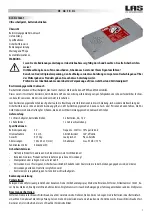
Electrical Maintenance (Rev 6/98)
43
BATTERY
NOTE: The PROCESSOR On-Off switch must be placed
in the OFF position before connecting or disconnecting
the battery terminals. The PROCESSOR On-Off switch is
located on the side of the control box inside the engine
compartment.
Inspect/clean the battery terminals and check the electrolyte
level during scheduled maintenance inspections. A dead
or low battery can be the cause of an ammeter indicating
discharge due to lack of initial excitation of the alternator
even after the unit has been boosted for starting. The mini-
mum specific gravity should be 1.235. Add distilled water
as necessary to maintain the proper water level.
UNIT WIRING
Inspect the unit wiring and the wire harnesses during sched-
uled maintenance inspections for loose, chaffed or broken
wires to protect against unit malfunctions due to open or
short circuits.
CHARGING SYSTEM
Immediately after start-up, the ammeter may show a dis-
charge condition on systems with brush type alternators.
This is due to light film build-up on the alternator slip rings.
The film build-up occurs primarily on units that have been
sitting unused for long periods of time. The film should dis-
appear after a minute or two, and the ammeter should show
a high charge rate that will continue until the battery voltage
is brought back to normal.
Under normal running conditions, the ammeter will show a
slight charge condition. If the ammeter shows a discharge
after start-up, check the alternator belt tension and all charg-
ing circuit connections including the battery.
GLOW PLUGS
Glow plugs heat the combustion chamber to aid in quick
starting. The glow plugs are energized when the Preheat-
Start switch is held in the PREHEAT or START position or
when the microprocessor initiates unit start-up.
An open glow plug (burned out) can be detected with the
unit ammeter. The unit ammeter should show 28 to 30 amps
discharge while the unit is preheating. A discharge of 28 to
30 amps means all four glow plugs are working. If the dis-
charge rate drops below 28 amps on PREHEAT, at least one
glow plug is bad.
To isolate an open glow plug, remove the jumper bar and
test each glow plug individually with an ohmmeter or a
jumper wire and ammeter. Each glow plug should have a
resistance of approximately 1.8 ohms or a current draw of
about 7.1 amps.
A shorted glow plug will be indicated by the ammeter
showing full discharge when the preheat switch is pressed,
by CB2 tripping or by a burnt out fuse link. Check each
glow plug. A shorted glow plug will have very low resis-
tance.
FUSES
A number of fuses, located on the relay board, protect vari-
ous circuits and components. The relay board is located
inside the control box. Refer to the appropriate THERMO-
GUARD Microprocessor Controller Operation & Diagnosis
Manual for a complete list of the size and function of the
fuses.
•
A 40 amp fuse (F9—#2 Circuit) protects the 2AA cir-
cuit, which is the main power circuit.
•
A 15 amp fuse (F3—Damper) protects the 29F circuit,
which supplies power to the damper solenoid.
Summary of Contents for Super II SR+
Page 4: ......
Page 10: ...ii ...
Page 14: ...4 ...
Page 22: ...Unit Description Rev 6 98 12 Front View AEA1350 ...
Page 23: ...Unit Description Rev 6 98 13 Right Side Door Open AEA1351 ...
Page 24: ...Unit Description Rev 6 98 14 Left Side Doors Open AEA1352 ...
Page 26: ...Operating Instructions Rev 6 98 16 Control Box Cover AEA1354 ...
Page 34: ...24 ...
Page 42: ...Electronic Controls Rev 6 98 32 SOFTWARE REVISION 04XX ALARMS AEA1358 ...
Page 82: ...72 ...
Page 90: ...80 ...
Page 116: ...106 ...
Page 120: ...110 ...
Page 130: ...120 ...
Page 141: ...131 Schematic Diagram SBIII SII RMNII 30 SR MPIV ...
Page 142: ...132 Wiring Diagram SII SBIII RMN30 SR MPIV Page 1 of 4 ...
Page 143: ...133 Wiring Diagram SII SBIII RMN30 SR MPIV Page 2 of 4 ...
Page 144: ...134 Wiring Diagram SII SBIII RMN30 SR MPIV Page 3 of 4 ...
Page 145: ...135 Wiring Diagram SII SBIII RMN30 SR MPIV page 4 of 4 ...
















































